Potrebujeme váš súhlas na využitie jednotlivých dát, aby sa vám okrem iného mohli ukazovať informácie týkajúce sa vašich záujmov. Súhlas udelíte kliknutím na tlačidlo „OK“.
ASTM E502-07(2013)
Standard Test Method for Selection and Use of ASTM Standards for the Determination of Flash Point of Chemicals by Closed Cup Methods
Automaticky preložený názov:
Štandardná skúšobná metóda pre výber a použitie ASTM noriem pre stanovenie bodu vzplanutia chemických látok prostredníctvom Closed Cup metódy
NORMA vydaná dňa 1.10.2013
Informácie o norme:
Označenie normy: ASTM E502-07(2013)
Poznámka: NEPLATNÁ
Dátum vydania normy: 1.10.2013
Kód tovaru: NS-47003
Počet strán: 6
Približná hmotnosť: 18 g (0.04 libier)
Krajina: Americká technická norma
Kategória: Technické normy ASTM
Kategórie - podobné normy:
Anotácia textu normy ASTM E502-07(2013) :
Keywords:
ICS Number Code 71.080.01 (Organic chemicals in general)
Doplňujúce informácie
| Significance and Use | ||||||||||||||||||||||||
|
5.1 The flash point measures the response of the sample to heat and flame under controlled laboratory conditions. It is only one of a number of properties that must be considered in assessing the overall flammability hazard of a material. 5.2 As a result of physical factors inherent in the apparatus and procedure, the closed cup flash point does not necessarily represent the minimum temperature at which a material can evolve flammable vapors, and the absence of a flash point does not guarantee nonflammability (see Appendix X1 and Appendix X2). 5.3 Flash point is used in shipping and safety regulations to define flammable and combustible materials. Test Methods D56, D93, and D3278 are specified as test methods for determining the flash point of these materials. 5.4 If the process or handling conditions dictate the usage of a flammable material at temperatures ranging upward from 5 to 10°C below the closed-cup flash point, then a flammable vapor might be present above the liquid. In such cases, it may be more appropriate to use the temperature limit of flammability (as determined by Test Method E1232) instead of flash point. 5.5 Small scale methods involving equilibrium procedures and only one flame pass per specimen are preferred. |
||||||||||||||||||||||||
| 1. Scope | ||||||||||||||||||||||||
|
1.1 This test method covers the determination of the flash point of liquid and solid chemical compounds flashing from below − 10 to 370°C (16 to 700°F). The procedures and apparatus in Test Methods D56, D93, D3278, D3828, and D3941 are to be used. Modification to these procedures are specified for tests on solids and viscous liquids. The significance of the results obtained is discussed along with possible sources of error and factors that might cause interference. 1.2 Suggestions for adapting this procedure to mixtures of chemicals are included (see Appendix X2). 1.3 This test method should be used to measure and describe the properties of materials, products, or assemblies in response to heat and flame under controlled laboratory conditions and should not be used to describe or appraise the fire hazard or fire risk of materials or assemblies under actual fire conditions. However, results of this test method may be used as elements of a fire risk assessment that take into account all of the factors that are pertinent to an assessment of the fire hazard of a particular end use. 1.4 Warning—Mercury has been designated by EPA and many state agencies as a hazardous material that can cause central nervous system, kidney and liver damage. Mercury, or its vapor, may be hazardous to health and corrosive to materials. Caution should be taken when handling mercury and mercury containing products. See the applicable product Material Safety Data Sheet (MSDS) for details and EPA’s website – http://www.epa.gov/mercury/faq.htm - for additional information. Users should be aware that selling mercury and/or mercury containing products into your state may be prohibited by state law. 1.5 This standard does not
purport to address all of the safety concerns, if any, associated
with its use. It is the responsibility of the user of this standard
to establish appropriate safety and health practices and determine
the applicability of regulatory limitations prior to use.
Standard Test Method for Flash Point and
Fire Point of Liquids by Tag Open-Cup Apparatus Standard Test Methods for Flash Point of
Liquids by Small Scale Closed-Cup Apparatus Standard Test Method for Flash Point by
the Equilibrium Method With a Closed-Cup Apparatus Standard Test Method for Flash/No Flash
Test´Equilibrium Method by a Closed-Cup Apparatus Methods of Sampling Petroleum and
Petroleum Products (Withdrawn 1982) Standard Test Methods for Flash Point by
Pensky-Martens Closed Cup Tester Standard Test Method for Flash and Fire
Points by Cleveland Open Cup Tester Standard Test Method for Flash Point by
Tag Closed Cup Tester Standard Test Method for Estimation of
Solubility of Gases in Petroleum and Other Organic Liquids Standard Test Methods for Flash Point by
Small Scale Closed Cup Tester (Includes all amendments and changes
7/26/2021). Standard Test Method for Concentration
Limits of Flammability of Chemicals (Vapors and Gases) Standard Test Method for Temperature
Limit of Flammability of Chemicals |
Podobné normy:
Historická
15.6.2012
Historická
1.11.2012
Historická
1.11.2012
Historická
1.12.2012
Historická
1.5.2014
Historická
1.4.2012


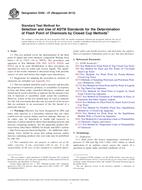
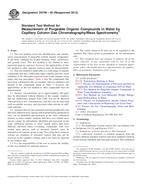 ASTM D5790-95(2012)..
ASTM D5790-95(2012)..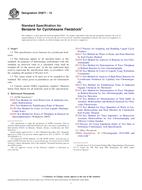 ASTM D5871-12
ASTM D5871-12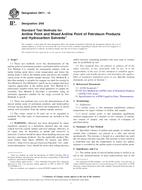 ASTM D611-12
ASTM D611-12 ASTM D6875-12
ASTM D6875-12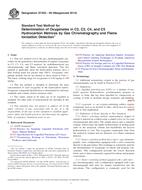 ASTM D7423-09(2014)..
ASTM D7423-09(2014)..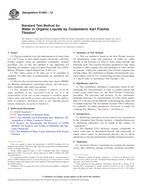 ASTM E1064-12
ASTM E1064-12
 Cookies
Cookies
